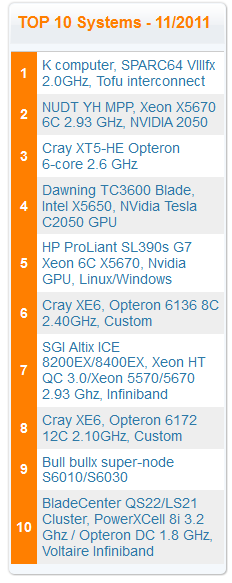Top 10 supercomputers hold position: Intel, IBM, Nvidia shine

Japan's K Computer remained the fastest supercomputer on the planet, but perhaps the biggest takeaway and is that it is also the most energy efficient.
The Top500 list---compiled by Hans Meuer of the University of Mannheim, Germany; Erich Strohmaier and Horst Simon of NERSC/Lawrence Berkeley National Laboratory; and Jack Dongarra of the University of Tennessee---tracks the pecking order of supercomputers. The high-performance computing market isn't a massive revenue generator, but chipmakers use these high-profile wins to bolster enterprise cred. After all, if a chip is good enough to model weather patterns it's probably good enough for your data center.

In June, the K Computer was also No. 1, but it wasn't fully built out. The K Computer doesn’t use graphics processors or accelerators.
No. 2 remained the Chinese Tianhe-1A system with 2.57 Petaflop/s. In fact, the top 10 supercomputers maintained position (right).
Among the key items to note:
- 29 systems on the list use more than 1 megawatt of power. The K Computer consumes 12.66 MW, but is the most efficient with 830 Mflops/watt.
- The most energy efficient system is the BlueGene/Q with 2,029 Mflops/watt.
- China has 75 systems in the top 500 list and is No. 2 to the U.S.
- Nvidia GPUs are being used in the No. 2 and No. 4 Chinese systems as well as the Japanese Tsubame 2.0 system at No. 5.
- 39 systems use GPUs, up from 17 six months ago. Of those GPU systems, 35 of them use Nvidia.
- Intel has the largest share of top 500 systems with 76.8 percent of the market, down from 77.2 percent six months ago. AMD's share of the top 500 systems is 12.6 percent (63 systems down from 66 six months ago).
- IBM Power processors power 49 systems in the top 500 list.
- IBM has 223 systems in the list good for 44.6 percent of the market. HP has 28 percent, or 140 systems.
More: